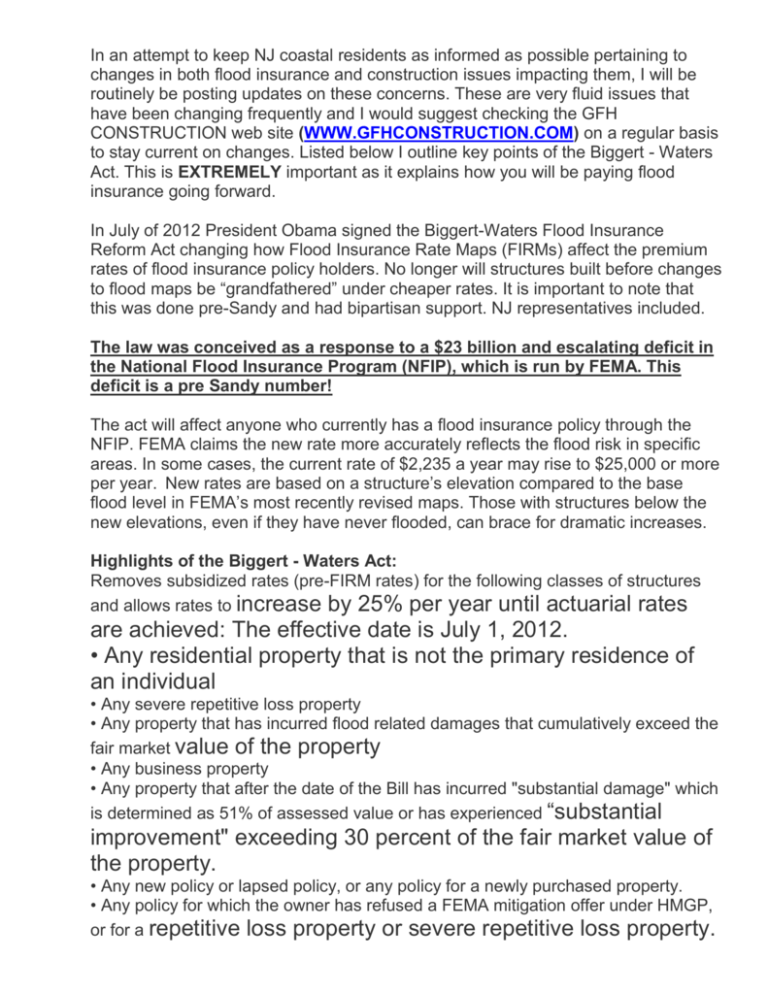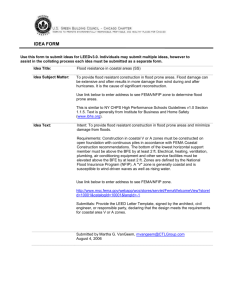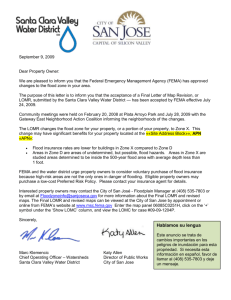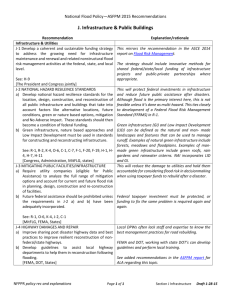more - GFH Construction
advertisement

In an attempt to keep NJ coastal residents as informed as possible pertaining to changes in both flood insurance and construction issues impacting them, I will be routinely be posting updates on these concerns. These are very fluid issues that have been changing frequently and I would suggest checking the GFH CONSTRUCTION web site (WWW.GFHCONSTRUCTION.COM) on a regular basis to stay current on changes. Listed below I outline key points of the Biggert - Waters Act. This is EXTREMELY important as it explains how you will be paying flood insurance going forward. In July of 2012 President Obama signed the Biggert-Waters Flood Insurance Reform Act changing how Flood Insurance Rate Maps (FIRMs) affect the premium rates of flood insurance policy holders. No longer will structures built before changes to flood maps be “grandfathered” under cheaper rates. It is important to note that this was done pre-Sandy and had bipartisan support. NJ representatives included. The law was conceived as a response to a $23 billion and escalating deficit in the National Flood Insurance Program (NFIP), which is run by FEMA. This deficit is a pre Sandy number! The act will affect anyone who currently has a flood insurance policy through the NFIP. FEMA claims the new rate more accurately reflects the flood risk in specific areas. In some cases, the current rate of $2,235 a year may rise to $25,000 or more per year. New rates are based on a structure’s elevation compared to the base flood level in FEMA’s most recently revised maps. Those with structures below the new elevations, even if they have never flooded, can brace for dramatic increases. Highlights of the Biggert - Waters Act: Removes subsidized rates (pre-FIRM rates) for the following classes of structures and allows rates to increase by 25% per year until actuarial rates are achieved: The effective date is July 1, 2012. • Any residential property that is not the primary residence of an individual • Any severe repetitive loss property • Any property that has incurred flood related damages that cumulatively exceed the fair market value of the property • Any business property • Any property that after the date of the Bill has incurred "substantial damage" which is determined as 51% of assessed value or has experienced “substantial improvement" exceeding 30 percent of the fair market value of the property. • Any new policy or lapsed policy, or any policy for a newly purchased property. • Any policy for which the owner has refused a FEMA mitigation offer under HMGP, or for a repetitive loss property or severe repetitive loss property. * Severe Repetitive Loss means four or more claims payments of over $5,000 or two claims that exceed the value of the property. In addition the bill states that beach nourishment is not an allowed mitigation activity, and adds elevation, relocation, demolition, rebuilding or flood-proofing of utilities as allowed mitigation activities. In summary, while many are hoping that there may be some relief of the Biggert Waters Act, the probability is very slim. FEMA has lost a tremendous amount (Billions) and with the current policy of deficit reduction, it is highly unlikely. It is important to remember that FEMA is in the insurance game because the private sector views it as too risky. Tax payers in non flood areas do not want to see their tax dollars used to subsidize flood prone areas. Don't kill the messenger here, just stating the facts. If you live in a property that requires flood insurance your best bet is to mitigate and become FEMA compliant through ICC monies, SBA grants, Community Development Block Grants, bank workouts, or whatever resources you may have available to you. If you have additional questions please check my website at (WWW.GFHCONSTRUCTION.COM) or feel free to email me at Cgallagher@gfhenterprises.com and I will do my best to assist you in getting a straight answer. I wish you the best in dealing with this very unfortunate and challenging situation.






